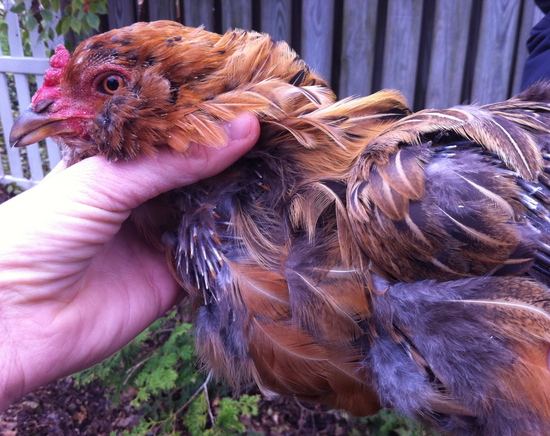Backyard Chickens: Time to molt!

Pin feathers are evident along the neck of this molting Americauna.
Corinna Borden | Contributor
Thank goodness for Mother Nature. Just when I thought all was staid, she sends the message to our chickens: Time to molt.
The first inkling that something was amiss began at the beginning of November. Though I was unsure as to why, we had been told to keep track of daily egg production by people we trusted. A few weeks ago, our numbers dropped off precipitously and stayed dropped. Three to four eggs a day became one. I am grateful we had been keeping track of production, because it put us on notice to be more attentive to their subsequent behavior.
After a week of decreased production, more feathers were on the bottom of the coop than I had ever seen before. Our chickens also became highly skittish. Whereas before when we brought out treats, they would say hello — some of them even jumping up on shoulders and knees — now most stayed away.
Diminished egg production and loss of feathers could indicate several fowl situations (pun intended). Mites, lice, poor nutrition, general stress or molting were all possibilities. Just when I had decided to read about mites, I was able to catch one of the skittish birds.
According to the Western Australian Department of Agriculture Farmnote from January 1979, “the three main factors that bring about moulting are: physical exhaustion and fatigue; completion of the laying cycle (as birds lay eggs for a certain period of time); and reduction of the day length, resulting in reduced feeding time and consequent loss of body weight.”
Pullets are expected to produce eggs continuously for 11 months before taking a break to build up their bodies' reserves of nutrients. Our girls started laying in late December, so we were right at 11 months. Day length is certainly shorter.
When I was able to catch a bird, I saw pin feathers coming out of her neck — a molt it is! Pin feathers look like short clear straws with tightly compressed feathers tufting through the very top.
(In this video you can see the difference between a molting Buff Orpington and one with full plumage.)
“The first plumage is lost from the head and neck, then from the saddle, breast and abdomen (body), then from the wings and finally from the tail,” according to the Australian Farmnote. As we watch for our birds to pass through the stages of molting, we are reminded of our initial adoration for our backyard chickens. It's probably good for us to take a break from eating eggs anyway.
Corinna wrote a book about many things, works with the Westside Farmers Market, and spoils her backyard chickens.


Comments
Jim Pryce
Mon, Nov 29, 2010 : 12:23 p.m.
Some of my gals are molting. I put a light on a timer in the coop & the egg production has picked up from 3-4 to 6-8. Last Saturday I got 10. I am in Superior Township & can have many chickens(14 layers) & waiting on 14 other pullets to start to be exact.